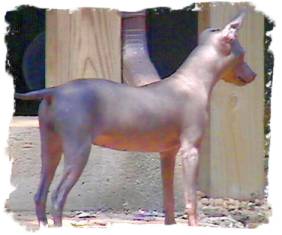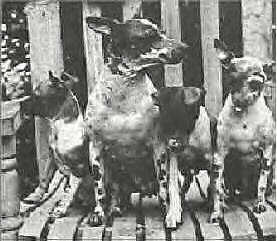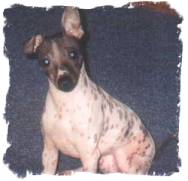

AHT Breed History, Part 2
American Hairless Terrier by Teri Murphy and Bonnie Turner
![]()
 |
In the history and "lore" of most breeds were events that became a recognized part of a breeds history. There may also have been some things that happened so rarely they were overlooked and forgotten. In the history of the rat terrier breed, there have been, and continue to be, sporadic reports of hairless puppies born to normal coated rat terrier parents. |
| In more recent history, they might be explained as being related to the very first reported hairless rat terriers, reputed to be the result of a rare spontaneous mutation. Or, they could be a result of hairlessness being a seldom seen, but nonetheless inherent, trait in the rat terrier or one of its parent breeds. However they got here, the history of the American Hairless Terrier as we know it, began in 1972, when Edwin Scotts neighbor gave him a little hairless female.This hairless puppy was born in a litter of normal looking coated puppies, and was produced by coated mid-sized rat terrier parents. In a previous litter, the same two parent dogs had produced a hairless puppy, which was lost, probably from exposure. This second puppy, however, was very vigorous, and grew just as well as her siblings. Mr. Scott named her Josephine. |
|
| As he and his family lived with her, and her progeny, they came to realize what a gift this hairlessness would become. Because these hairless dogs are so easy to keep clean and pest free, people who don't want to be bothered with fleas and hair can experience "dog joy" free of those annoyances. But even more important than "convenience" is the true joy experienced by a family that could never before have a dog. Allergies keep millions of people from being able to live with coated dogs. Those of us who have not been denied this pleasure have no idea what a loss that can be. |  |
| Almost every breeder of these hairless dogs has come to know their true value through an association with the families who need them. It is very difficult for non-allergic family members to be denied a much wanted pet because another family member cannot tolerate living with it. The situation for the allergic individual can be even more painful! Not only are they unable to have the pet they want, but they might also feel responsible for the loss the rest of the family must endure. Happily for them all, it appears that a higher percentage of sensitive persons can tolerate this hairless breed, than any other breed in the world! These hairless dogs produce a normal amount of lubricating skin oil, the same as do coated dogs. With no coat to disperse onto, the oil serves another purpose, most important to sensitive people. Between baths, the oil stays on the surface of the skin, and traps the normal dander that all skin produces, thus keeping the dander out of the environment, and making it less of a threat to an allergic person. When the dog is bathed, the dander goes down the drain. This breed appears to be well able to tolerate being bathed two or even three times weekly. Their skin is surprisingly durable, even though it lacks the protection of a haircoat. That same lack of a haircoat, however, does make the skin very susceptible to sunburn. They must be protected by clothing or sunblock. As far as how the weather affects them, these dogs are very similar to their coated counterparts. They are able to tolerate limited exposure to cold better than prolonged exposure to heat and humidity. Overall, they are every bit as tough and active as their coated brethren. |
|
 |
The personality of this hairless terrier is that of any terrier. Given the opportunity to hunt squirrel, dig for moles, catch vermin or chase a ball, these dogs will be right in the middle of the hunt or the chase! They are now also being proven in the agility ring. There are numerous accounts of our hairless friends working a tree, killing vermin, and digging for underground treasures. For most owners, nothing is more pleasurable than watching them do what comes naturally. |
|
But when it is time to settle in their owners lap or sit by their side, they are right there, ready to enjoy the companionship of their humans. There are numerous accounts of our hairless friends working a tree, killing vermin, and digging for underground treasures. For most owners, nothing is more pleasurable than watching them do what comes naturally. But when it is time to settle in their owners lap or sit by their side, they are right there, ready to enjoy the companionship of their humans. They do tend to bond closely with their families, so early socialization is important. This hairless terrier is different from all other hairless breeds in several ways. Most evident is the quality of its "hairlessness". The skin is so much softer and smoother than that seen in any other hairless breed. With the exception of some whiskers and eyelashes, it is totally hairless. Some individuals when viewed at an angle, in good light, may exhibit a very fine, downy "peach fuzz". Another notable difference from all other hairless breeds, is their normal dentition. There are no missing premolars, and the canine teeth are of normal size and set in a correct angle within the jaw. Very important to breeders is the fact that this hairlessness is a recessive trait, with no lethal gene, as is found in the other hairless breeds. Breeders may breed hairless to hairless without danger to the developing puppies. This most useful trait is what most of today's breeders are using to add new genetic material to the breed. As was reported by Mr. Scott, ( and is presently being confirmed by other breeders), it appears to work this way: A.) When a hairless
is bred to a hairless, all the puppies will always be hairless. On average, when a litter is produced that contains hairless and coateds, the numbers range around 50/50. (Half hairless and half coated carriers) The breed owes Edwin Scott a great deal of gratitude for having the foresight and tenacity to foster this hairless trait for so many years. He was the one who started exploring and learning some of the genetic information we still use today. He named his new breed the American Hairless Terrier, and most of what we know of them came from his observations. In January 1999 the Rat Terrier was fully recognized by UKC. At the same time, these hairless "cousins" became recognized as the hairless version of the more familiar coated rat terrier. Since the foundation hairless lines had been inbred for so many years, it was very important to introduce new, unrelated rat terrier lines to the foundation hairless dogs. After enough breedings have been done to enlarge the gene pool and create more diverse hairless lines, breeders plan to petition UKC for separate breed status, and a return to the original name, The American Hairless Terrier. In the meantime, UKC has implemented extremely useful pedigrees to help all rat terrier breeders keep track of certain traits within a dogs pedigree. For example, by reading a pedigree, a breeder can decide whether or not they wanted to include the trait for a natural bob tail. So too, by reading a pedigree, may a breeder decide whether or not they want to include the trait for hairlessness. Both traits are part of rat terrier heritage, and both traits can be selected for, or against. They are clearly recorded in all the generations listed on a dogs UKC pedigree. Most breeders of the hairless are keenly aware of the responsibility they have to this variety and are strongly in favor of health testing, DNA profiling and placing all pets on a spay/neuter contract. In their quest for even further improvement of this most delightful member of dogdom, most breeders are working together, sharing knowledge and a firm commitment to future members of this breed, and the families who will love them. For the future of the breed with UKC, the goals of most breeders are: Short Term: To gain
full Variety status in the Conformation Ring. Our most sincere and heartfelt Thank You to UKC for allowing us the opportunity to preserve our pedigrees in a safe environment and within the ranks of this highly respected registry. Without your help and guidance, the progress we have made would not have been possible. Thanks also, to the Rat Terrier community for being instrumental in the preservation of this unique trait. And thank you to TheDogPlace.com for the opportunity to introduce this fascinating breed to the world! Not many new breeds have been fortunate enough to have so much help during their development. Many future owners will come to know and benefit from this breed because of your help.
|
| Bonnie
Turner- AHRTC Treasurer |
Teri
Murphy - AHRTC President |
![]()
Take
me back to the top!
Previous
Page | Next
Page | Home
| Site
Map | Email
Us
![]()
Website design and header graphics by: Silent
Caiman Web Design. Wudnshu AHT Logo designed by Argostar.
B/W Photo
used with permission of AHRTC.
Other photos used with permission of owners.
This site ©2003 Wudnshu AHTs unless otherwise noted.